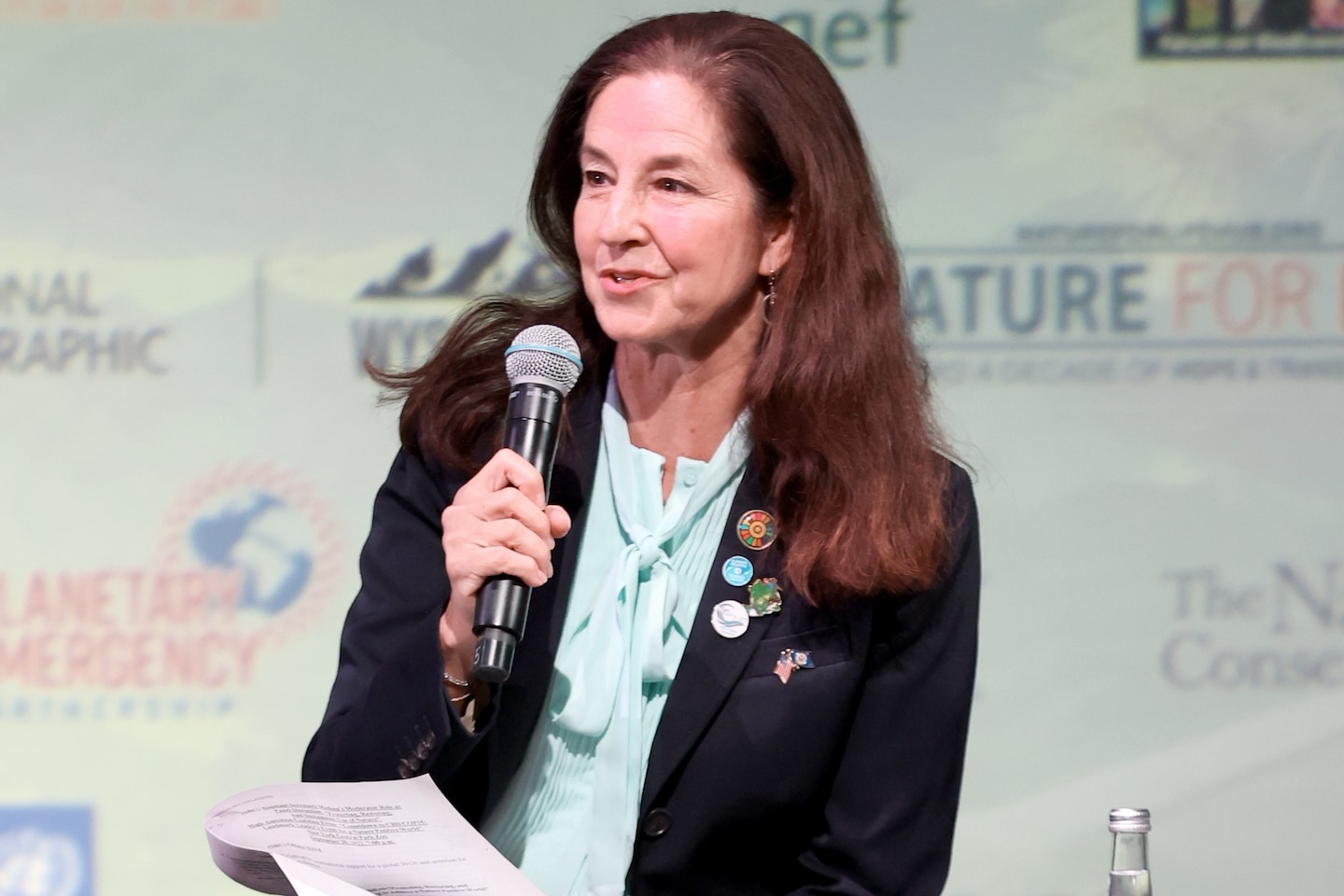
Comment on this story Comment Gift Article Share
Good morning and welcome to The Climate 202! Dino Grandoni, a national environment reporter for The Washington Post, wrote the top of today’s newsletter. Below we have the latest on Hurricane Ian’s devastating impact in Florida. But first: Wp Get the full experience. Choose your plan ArrowRight In a first, U.S. appoints a diplomat for plants and animals As temperatures rise and habitats shrink, hundreds of thousands of plant and animal species around the world are at risk of vanishing.
For the first time, the United States is designating a special diplomat to advocate for global biodiversity amid what policymakers here and overseas increasingly recognize as an extinction crisis.
Monica Medina is taking on a new role as special envoy for biodiversity and water resources, the State Department announced Wednesday. She currently serves as the department’s assistant secretary for oceans and international environmental and scientific affairs.
The appointment underscores the Biden administration’s desire to protect land and waters not just at home but to also conserve habitats abroad.
‘Not just about nature for nature’s sake’
The loss of biodiversity isn’t just a tragedy for wildlife. It’s one of the biggest threats facing humanity.
According to a major U.N. report in 2019, a million species face possible extinction, with dire implications for humans who depend on ecosystems for food, fresh water and other resources. Overfishing, pollution, pesticides, disease, urban sprawl and, of course, climate change contribute to declines in imperiled species’ populations worldwide.
“There’s a direct connection between biodiversity loss and instability in a lot of parts of the world,” Medina said in a recent phone interview. “It’s not just about nature for nature’s sake. I think it is about people.”
Before the Biden administration, Medina was an adjunct professor at Georgetown’s Walsh School of Foreign Service and worked as general counsel of the National Oceanic and Atmospheric Administration, among other government roles. She is the wife of White House Chief of Staff Ron Klain.
Her appointment comes weeks ahead of a major biodiversity conference in mid-December in Montreal. The meeting originally was scheduled to take place in the Chinese city of Kunming in 2020 but was delayed by the coronavirus pandemic.
The aim of the U.N. Convention on Biological Diversity — also known as COP-15 — is for nations to reverse the loss of species by adopting an international framework for conserving biodiversity. The effort is akin to the climate talks in 2015 that yielded the Paris agreement.
What the United States wants out of the conference: For nations to commit to conserving 30 percent of their land and water area. “We are looking for ways to reach that goal, because that’s what scientists tell us we need in order to have a healthy planet,” Medina said.
One big hurdle: Defining what, exactly, counts as land and water conserved? “That is part of the discussion, is what counts,” she said.
Is the United States doing its part? President Biden set a goal of conserving nearly a third of the nation’s land and waters by 2030.
Biden has taken a few steps toward that target, restoring protections for two desert expanses in Utah and reinstating fishing restrictions in a marine monument off New England. Both moves reversed decisions made by President Donald Trump.
But the Biden administration has yet to identify many other specific places for new protections. Medina noted that the Inflation Reduction Act passed this year set aside billions of dollars for conservation funding.
The link between biodiversity and climate change
But protecting ecosystems such as forests and peatlands, Medina noted, will help keep climate-warming carbon out of the atmosphere in the first place.
“It’s a crisis that we face that’s interwoven with the climate crisis, but also independent and important on its own,” she said. “If we can solve the biodiversity crisis, we’re a long way along the way to solving the climate crisis.”
Update: This story has been updated to include that Medina is married to White House Chief of Staff Ron Klain.
Extreme events
Ian moves inland, inundating coastal Florida and knocking out power to 2.5 million
Hurricane Ian gradually weakened into a tropical storm early Thursday, with maximum sustained winds of 65 mph. Although storm surge is thought to have already peaked, Florida Gov. Ron DeSantis warned late Wednesday that decimation is likely to continue throughout the state, Jason Samenow, Kelly Kasulis Cho and Annabelle Timsit report.
Meanwhile, the National Hurricane Center said Ian, which is tearing toward Florida’s Atlantic coast, is expected to further weaken Friday night and into Saturday, but “could be near hurricane strength” on Friday when it approaches South Carolina.
About 2.5 million customers are without power, according to PowerOutage.us, which tracks outages across the country. Conditions are expected to deteriorate as Ian moves inland.
Ian jumped from a Category 3 storm Tuesday night to just shy of a Category 5 on Wednesday morning, a distinct marker of climate change. The rapid intensification of storms, which has occurred more frequently in recent decades, is tied to rising ocean temperatures. The warmer water helps fuel hurricanes, allowing them to grow, strengthen and release more rain.
Other updates include:
The monster storm will drop 12 to 20 inches of rain over central and northeast Florida, with localized amounts up to 30 inches, according to the National Hurricane Center . Flash flooding is one of the most serious threats from tropical storms because it happens quickly and occurs far from shore. The slow-moving nature of Ian means that torrents of rain will fall across the state for a longer period of time.
In a news briefing Wednesday night, DeSantis said there would be an influx of personnel and supplies available to those in need, and that first responders would probably be able to reach residents in high-risk areas when conditions are safer at first light Thursday.
DeSantis also sent an official letter to President Biden on Wednesday requesting a major disaster declaration for the entire state, asking for full federal reimbursement of response and recovery costs for the first 60 days.
Pressure points
Millions of people moved into Ian’s path in the past 50 years
The swath of coastline that is facing the most disastrous effects from Hurricane Ian has been undergoing rapid development in recent decades, putting exponentially more assets and people in harm’s way, The Washington Post’s Simon Ducroquet, Brady Dennis and John Muyskens report.
From 1970 to 2020, census records show that the Cape Coral-Fort Myers area expanded by 623 percent to more than 760,000 people. At the same time, the Tampa-St. Petersburg-Clearwater area saw growth of more than 187 percent and is now home to more than 3.1 million people.
Stephen Strader, a hazards geographer and professor at Villanova University, said as more people and businesses move to the beach, it creates an overwhelming opportunity for weather-related disasters to wreak havoc.
“Then throw on sea level rise and climate change on top of that, and you are looking at a multi-headed monster,” Strader said. “We really haven’t done much to check this growth. … What we are finding out is that is not sustainable.”
Why the defeat of Manchin’s energy bill could be a loss for the climate
After Sen. Joe Manchin III (D-W.Va.) on Tuesday said that he was pulling his energy permitting plan from a stopgap government funding bill, many environmental groups rejoiced. But the bill also included a provision to rapidly expand transmission lines, which are crucial for helping the United States meet its bold climate goals, Shannon Osaka reports for The Post.
Manchin’s bill, dubbed the Energy Independence and Security Act, was intended to help speed the approval process for new clean and fossil-fuel energy projects by setting up a two-year target for environmental reviews and granting the federal government the authority to build transmission lines.
However, many climate activists argued that although the bill would accelerate the nation’s transition to clean energy, its potential benefits do not outweigh the harms of locking in additional greenhouse gas emissions for decades to come.
Still, those power lines are necessary for carrying renewable electricity from sunny and windy areas of the country to urban centers. According to an analysis from Princeton University, the newly passed Inflation Reduction Act could cut U.S. emissions 40 percent by 2030 compared to 2005 levels. But that calculation hinges on whether the nation manages to increase transmission by 2.3 percent per year. If transmission grows only 1 percent per year, the modelers predict that 80 percent of the new climate law’s benefits could be lost.
International climate
E.U. warns of ‘robust’ response against sabotage after Nord Stream blasts
European Union leaders on Wednesday launched investigations into random, simultaneous breaches of three major underwater natural gas pipelines in the Baltic Sea, pointing to Russian sabotage, Meg Kelly and Michael Birnbaum report for The Post.
Experts said the blasts potentially mark the largest-ever single release of methane into the atmosphere from the energy sector. The gas is more than 80 times more powerful than carbon dioxide during its first 20 years in the atmosphere. Thomas Lauvaux, a researcher with the Laboratory of Climate and Environmental Sciences in France, said that in a worst-case scenario the leak could cause the same amount of planet-warming pollution that 1 million cars do in a year.
On Wednesday, E.U. foreign policy chief Josep Borrell vowed a “robust and united response” to any attacks on the 27-nation bloc’s energy infrastructure. Though the probes have only just begun, many politicians blamed Russia, saying that the explosions are the next step in the Kremlin’s strategy as it continues to wage a war in Ukraine and use energy supplies as leverage over Europe.
Kremlin spokesman Dmitry Peskov called accusations that Russia was responsible for the explosions “predictably stupid” and “absurd.” He told reporters on a call that Moscow has no interest in damaging the pipelines — which are majority-owned Russian entities — because of the high value of the gas.
In the atmosphere
Viral
Moose boops! 🥰
📷: Intern, Christina pic.twitter.com/2p06gzQ5uR — Northwest Trek Wildlife Park (@NorthwestTrek) September 28, 2022
Thanks for reading!
GiftOutline Gift Article








